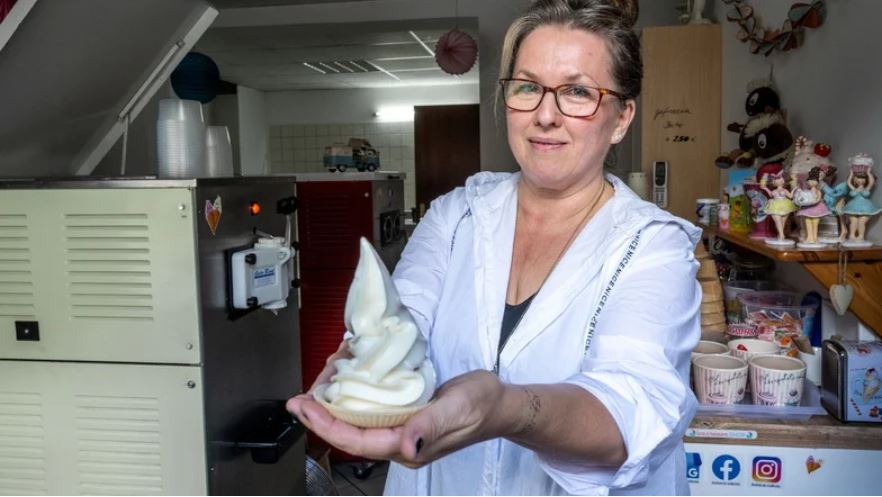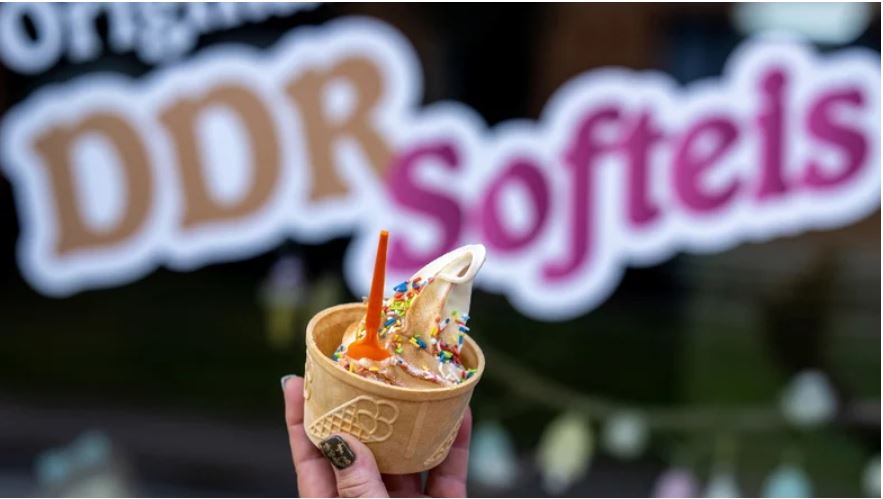Naumburg/Leipzig. These words have proven to be a revenue generator for Steffen Pretzsch. Since two boards at his café near Naumburg's venerable cathedral announce that he sells "original GDR soft ice cream," his ice cream sales have doubled, the 56-year-old says. "I wouldn't have thought that was possible." Pretzsch is not the only seller of GDR soft ice cream; many ice cream parlors between Rügen and the Ore Mountains advertise the cool treat. But what is it anyway, GDR soft ice cream, why does it still sell so well?
First of all, GDR soft ice cream is not a protected regional brand like Thuringian Rostbratwurst, for example, says Torsten Langbein. He is head of sales at Ablig Feinfrost, which owns the Central German Ice Cream Museum in Heichelheim, Thuringia. "Anyone can hang out a flag and announce that they sell GDR soft ice cream." Nevertheless, he says, there is something like a general understanding, an "acquired taste" that many people associate - and still like - with the ice cream, which melts rather quickly.
A first big secret behind the GDR soft ice cream are the ice cream machines. A single manufacturer, VEB Kältetechnik Niedersachswerfen, produced soft ice cream machines in the GDR, the "Ilka Eisfreezer." "In the West, they were pump machines that whipped up to 30 percent air into the ice cream. In the East, there was no air," says café owner Pretzsch. Less air in soft ice cream means it's a little firmer. The "mouth feel" becomes a different one.
In fact, the old machines are still in use in quite a few ice cream stores. Ulrike Helbig (56) has a lot of experience in her "Ice factory" in Gößnitz, Thuringia three machines from the 80s are standing. Two produce her "original GDR soft ice cream," and one serves as a spare parts dispenser. Helbig started soft serve ice cream in 2015, alongside her main job in nursing. "I started it as a second mainstay and didn't know it would do so well." Since 2018, her full attention has been on ice cream.

However, soft ice cream is absolutely not an invention of the GDR. The idea for it came from the USA and was imported to Germany in the 1950s. According to Information from the Lower Saxony Consumer Protection Office soft ice cream is produced at significantly higher temperatures (-6 degrees) than conventional ice cream (-18 degrees). In the machines, a liquid ice cream mix - often mixed from powder and water - is cooled and filled into the ice cream cones as soft ice cream in its characteristic form.
The ice cream powder is a second answer to the question of what makes GDR soft ice cream. Ice cream manufacturer Helbig buys her soft ice cream mixes from various manufacturers, as she says. Café owner Pretzsch, on the other hand, relies on a producer that also supplied soft ice cream powder in GDR times: the Komet company from Großpostwitz in Upper Lusatia. It has to be "Classic" chocolate and vanilla - and mixed with water, "so that it tastes like it used to," says Pretzsch. The ice cream is "not so creamy, more refreshing, not so sweet.
In Großpostwitz, Sales Manager Sebastian Bartsch doesn't want to raise the GDR issue too high. "The genre "GDR soft ice cream" does not exist in food law," he says. Komet developed its soft ice cream mix in the 1950s/60s, he says. "But it would be unserious to say: we sell the same as before," says Bartsch. Nowadays, he says, you can use completely different raw materials, and the regulations for other additives such as flavors and colorants are completely different.
Nevertheless, "the basic idea of the ice cream is the same as in GDR times. But whether it tastes exactly the same - a lot happens in the mind," says Bartsch. Komet does not only sell its ice cream powder in the East. "We are noticing that we are increasingly selling to western Germany," says the sales manager. The ice cream mixes are now also going to retailers in Austria and even Italy. "That makes us happy, of course, that we can score points there with our soft ice cream."

This trend is also observed by a second major manufacturer, the company Anona in Colditz, Saxony. "In the west, interested parties are gradually emerging who want to include the traditional product soft ice cream in their portfolio," the company informs. The Colditz-based company produces around 1,000 tons of ice cream powder every year. Their recipe for the Original Schoko and Vanille varieties was developed in 1970. Basically, it has not changed much until today, the basic raw materials have been retained. The "taste of childhood" is simply still in demand in the East.
But what do customers actually say about GDR soft ice cream? Before the Cathedral Café by Steffen Pretzsch, a company outing from law firms and tax consultancies has stopped off. A woman devoutly laps up her ice cream and says, "Yes, yes, I would say it tastes like it used to." A colleague vehemently disagrees. In the GDR, soft ice cream was much creamier, he says. Pretzsch has an explanation for this. Even in the GDR, not all soft ice cream was the same: "Some people mixed it with milk. Then it tasted different, of course." (dpa)








